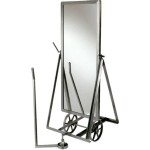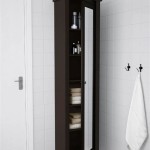How To Mount a Wall Mirror With Clips
Mounting a mirror with clips offers a sleek, modern look and provides extra security compared to relying solely on adhesive. This method is particularly suitable for heavier mirrors, ensuring a stable and long-lasting installation. Careful planning and precise execution are key to achieving professional results.
Planning and Preparation
Before commencing the installation process, several crucial steps must be undertaken to ensure a smooth and successful outcome. These preparatory measures lay the groundwork for a secure and aesthetically pleasing installation.
- Determine Mirror Placement: Carefully consider the desired location of the mirror, taking into account factors such as lighting, surrounding décor, and functionality.
- Check Wall Type: Identify the wall material (drywall, plaster, concrete, etc.) to select appropriate anchors and screws for secure mounting.
- Measure Mirror Dimensions: Accurate measurements of the mirror's height and width are essential for determining clip placement and ensuring proper support.
- Gather Necessary Tools and Materials: Assemble all required tools, including a level, drill, screwdriver, measuring tape, pencil, and safety glasses. Gather the necessary mounting hardware, including appropriate wall anchors, screws, and mirror clips specifically designed for the mirror's weight and thickness.
Positioning the Mirror Clips
Accurate placement of the mirror clips is critical for ensuring the mirror's stability and preventing it from shifting or tilting. Precise measurements and careful alignment are essential.
- Mark Clip Locations: Using the mirror's measurements, mark the desired locations for the clips on the wall. Generally, clips are placed along the bottom edge of the mirror and may also be used along the sides for added stability, particularly for larger or heavier mirrors.
- Use a Level: Employ a level to ensure the marked lines are perfectly horizontal and vertical, guaranteeing the mirror hangs straight.
- Consider Weight Distribution: For heavier mirrors, use more clips and distribute them evenly along the bottom and sides to provide adequate support.
Installing the Mirror Clips
Once the clip positions are marked, the next step involves securing the clips firmly to the wall. Proper installation of the clips is vital for the overall stability of the mounted mirror.
- Drill Pilot Holes: Carefully drill pilot holes at the marked locations, using the appropriate drill bit size for the chosen wall anchors.
- Insert Wall Anchors (If Necessary): If mounting to drywall or plaster, insert wall anchors into the pilot holes to provide a more secure grip for the screws.
- Attach the Clips: Securely fasten the mirror clips to the wall using appropriate screws, ensuring they are flush with the wall surface.
Mounting the Mirror
With the clips securely attached to the wall, the final step involves carefully placing the mirror onto the clips. Precision and caution are necessary to avoid damage to the mirror or the wall.
- Carefully Position the Mirror: Gently lift the mirror and position its bottom edge onto the lower clips, ensuring it is properly seated within the clip's gripping mechanism.
- Secure the Mirror: Once the bottom edge is secured, carefully lower the mirror into the side clips, if applicable, ensuring it is fully engaged with all clips.
- Check Stability: Gently but firmly tug on the mirror to confirm it is securely mounted and does not move or wobble. If any movement is detected, double-check the clip installation and tighten any loose screws.
Choosing the Right Clips
Selecting appropriate mirror clips is crucial for a secure and aesthetically pleasing installation. Different clips are designed for varying mirror thicknesses and weights, so choosing the correct type is essential.
- Consider Mirror Thickness: Mirror clips are designed to accommodate specific mirror thicknesses. Ensure the chosen clips are compatible with the thickness of your mirror.
- Account for Mirror Weight: Heavier mirrors require more robust clips capable of supporting their weight. Select clips with a weight capacity exceeding the mirror's weight.
- Choose the Right Style: Mirror clips come in various styles, including J-clips, L-clips, and decorative clips. Choose a style that complements the mirror and the overall aesthetic of the room.
Safety Precautions
Safety should always be a primary concern when undertaking any home improvement project. Taking appropriate safety measures can prevent accidents and ensure a safe working environment.
- Wear Safety Glasses: Protect your eyes from dust and debris by wearing safety glasses throughout the installation process.
- Use Gloves: Wearing gloves can protect your hands from sharp edges and provide a better grip on tools and materials.
- Enlist Assistance: For larger or heavier mirrors, enlist the help of another person to assist with lifting and positioning the mirror safely.
Alternative Mounting Methods
While mirror clips offer a secure and stylish mounting solution, other methods can be employed depending on the mirror's size, weight, and desired aesthetic.
- Adhesive: Specialized mirror adhesive can be used for lighter mirrors, offering a clean, frameless look.
- French Cleats: French cleats provide a robust and hidden mounting system suitable for heavier mirrors.
- Z-Clips: Z-clips offer another hidden mounting option, creating a floating effect.

How To Hang A Frameless Mirror On The Wall With Pictures

How To Frame A Mirror With Clips In 5 Easy Steps

How To Hang A Frameless Mirror On The Wall With Pictures

Removing A Bathroom Mirror Mounting Clips Or Brackets

How To Frame A Bathroom Mirror Over Plastic Clips Somewhat Simple

How I Installed A Really Big Mirror Merrypad Diy Network

How I Installed A Really Big Mirror Merrypad Diy Network

How To Hang A Mirrorand Toothpaste Tip

4pcs Chrome Mirror Wall Hanging Fixing Kit Frameless Clips Mounting Hanger Clamp

How To Diy Frame A Wall Mounted Mirror That Has Clips Flipping The Flip








